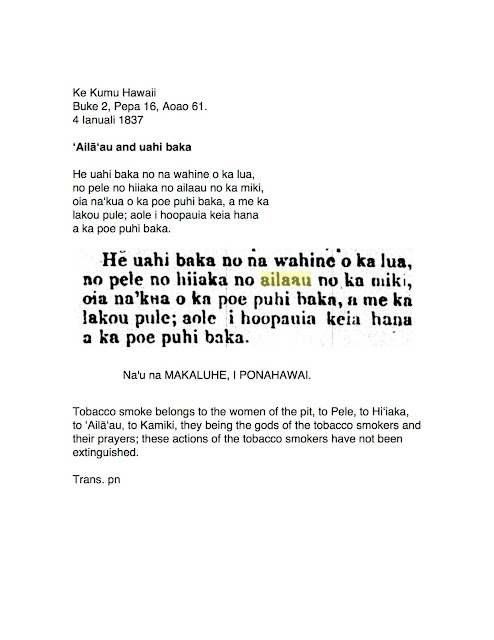I so want Her to slow down, that I donʻt trust my eyes when I see an apparent moderating of deflation. Those spikes are the ʻōlaʻi of the M3-something range. And itʻs tough...false hopes, the not knowing, the trying to live normally [I need some enchilada sauce! What? You like I make? Can? I know itʻs last-minute, but...], but these "distractions" are a good thing. No matter what, life does indeed go on.
Hereʻs a little thing about earthquakes, from USGS:
Today, up here at nearly 4,000 feet, itʻs blustery and cool. After the Kona sweltering a few days ago, itʻs refreshing. Billows of cloud skim Kaluapele, māhu (steam) rises from the floor, and windblown, streams down our new pali.
All this cloudy, fuming, vaporing reminded me of a little thing found in an OLD nūpepa. In the 1800ʻs, the Kingdom of Hawaiʻi was one of the most literate societies in the world. All told, 125,000 newspaper pages (between 1 million and 1.5 million typescript pages) in 100 different Hawaiian language newspapers were printed between 1834 and 1948, and they contain fascinating glimpses of those times. Just go to nupepa.org. and, if need be, Click on English text.
nupepa.org
Because Iʻm curious about him, I Searched for "Ailaau". Most of the results are mentions of people named Ailaau (ʻAilāʻau) in various documents.
But the first result was intriguing. Published on January 4, 1837 in Ke Kumu Hawaii, itʻs an article about smoking tobacco. Hereʻs a translation of part of the article by kuʻuhoa PN:
I can only wonder why, with the exchanges going on on Social Media about Pele and ʻAilāʻau, how come there arenʻt more references to him? As we saw in the Post dated July 20, 2018, he left when Pelehonuamea mā showed up in Keahialaka, never to be seen again. I wonder why?
Pele remains busy in Keahialaka. Hereʻs an image from Mr Durginʻs cam down there. Uahi ʻ awa rises straight up. No red visible, but Sheʻs there...
We keep track of things the best we can.
Below is from friend Andrew Richard Hara. You can purchase it and many others at
Andrew Richard Hara Eruption Relief
This, captured shortly after sunrise on June 20, 2018, is a favorite. Itʻs his Number 2591.
Undersea flows cause upwellings in the foreground, steam rises off ka ʻilikai, the skin, or surface, of the ocean, and it, along with the entry plume is blown onshore by strong trades. Waiapele (Kapoho Crater), her furrows lit by morningsun is at top right. And of course, Fissure 8, in Keahialaka, erupts at the left. Please take care and note that the dark area to the oblique left <<< of the roiling steam is its shadow. Kahawai pele, the lava stream, runs along the horizon, and is hidden by Waiapele, off the right edge of the image.
Here is yesterdays Flow Map. 855 acres of new pele added to our shore equals 1.33 square miles. Please update your atlases. Remember those??? And yes, Kumukahi is still the first to greet the sun.
I havenʻt been able to locate a Fire Map of the 15,000 acres (23.5 sq mi) burned ma uka of Waikoloa Village as of yesterday afternoon. Auē! As if the noeuahi wasnʻt bad enough over there, now the firesmoke and traffic detours add to the burden of residents.
You know, that entire arid region of South Kohala and North Kona on the Island of Hawaiʻi, the northwest, from near sea level up to more than 3,000 feet elevation, is blanketed with more than 200,000 acres of fountaingrass! It is listed as a Noxious Weed by the State Of Hawaiʻi. Yes, there is such a thing. In recent decades itʻs made its way to the pali of Waipiʻo in Hāmākua, and to Kaʻū. All from its debut as an ornamental in a yard at about an elevation of 2,000 feet on the dry side of North Kona in about 1910. Fountaingrass is from Africa, and is a cousin of kikuyugrass, with which it interbreeds.
The view below, on July 23, 2004 (14 years ago!) by Forest and Kim Starr, gives you some idea of the extent of the problem, looking from a puʻu near Waimea, over the fountaingrass-infested plain to Hualālai. Auē.....
Many many tens of thousands of acres of native dryland forest are severely impacted because fountaingrass grows so thickly native seeds canʻt even reach the ground to germinate and thrive, and worse, it carries fire extremely well. Itʻs an evil evil thing. And we are concerned for the hardworking, passionate folks of the Waikoloa Dry Forest Initiative, and pray that their efforts have not been in vain. Please learn at
https://waikoloadryforest.org/
Iʻll be here in the morning...
As always, with aloha,
BobbyC
maniniowali@gmail.com







No comments:
Post a Comment